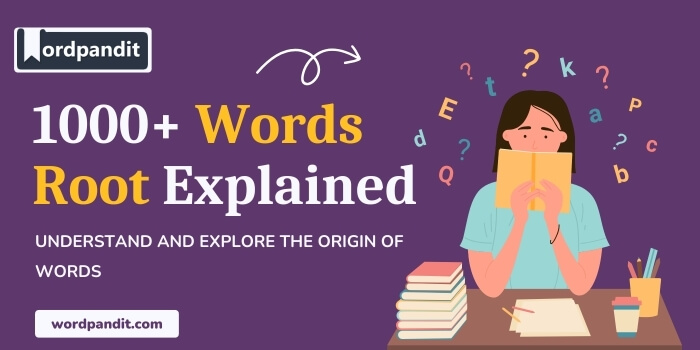Art: The Palette of Expression in Language and Culture
Byline: Explore the word root "Art," uncovering its profound implications in creativity, science, and communication. From its historical evolution to its relevance in modern expressions, discover how "Art" weaves through the fabric of language, design, and imagination.

Table of Contents
- Introduction: The Creative Spectrum of "Art"
- Etymology and Historical Journey
- Mnemonic: Unlocking the Power of "Art"
- Common "Art"-Related Terms
- "Art" Through Time
- "Art" in Specialized Fields
- Illustrative Story: "Art" in Action
- Cultural Significance of the "Art" Root
- The "Art" Family Tree
- FAQs about the "Art" Word Root
- Test Your Knowledge: "Art" Mastery Quiz
- Conclusion: The Enduring Legacy of "Art"
1. Introduction: The Creative Spectrum of "Art"
What defines human ingenuity better than the pursuit of "Art"? Rooted in the Latin word ars, meaning "skill" or "craft," "Art" encompasses creativity and mastery across fields. Pronounced "ahrt," this root is foundational in expressions of beauty, functionality, and innovation. Spanning painting, technology, and the art of conversation, "Art" symbolizes human effort to shape the world imaginatively and skillfully.
2. Etymology and Historical Journey
The journey of "Art" begins with the Latin ars, a word capturing the essence of craftsmanship, artistry, and technique. Medieval Europe elevated "Art" to a central pillar of education—the Artes Liberales—the liberal arts that shaped learned individuals. In the Renaissance, the word transcended technique to embody the profound pursuit of beauty and meaning.
By the Industrial Revolution, "Art" diverged into fine arts and applied arts, with fine art focusing on aesthetics and applied art marrying function with form. This evolution reflects society's changing values and its relationship with creativity.
3. Mnemonic: Unlocking the Power of "Art"
Think of "Art" as Aesthetic Refinement Transformed. Picture an artist shaping clay into a masterpiec
4. Common "Art"-Related Terms
- Artist (pronounced ar-tist)
- Definition: A person who creates art.
- Example: "The artist displayed her paintings in a local gallery."
- Artisan (pronounced ar-tuh-zan)
- Definition: A skilled craftsperson specializing in handmade goods.
- Example: "The artisan wove intricate patterns into the rug."
- Artificial (pronounced ar-tuh-fish-uhl)
- Definition: Made by human effort, often imitating natural phenomena.
- Example: "The artificial flowers looked almost real."
- Artifice (pronounced ar-tuh-fis)
- Definition: Clever or cunning devices or expedients, especially in deception.
- Example: "Her story was an artifice designed to distract."
- Articulate (pronounced ar-tik-yuh-late)
- Definition: Expressing ideas clearly and effectively.
- Example: "He is known for his ability to articulate complex ideas."
5."Art" Through Time
- Art (Ancient): Originally tied to manual skill or craft, such as blacksmithing or weaving.
- Shift: Renaissance thinkers redefined "Art" as a pursuit of beauty and intellectual depth.
- Artificial Intelligence (Modern): Extends the "Art" root to signify the creation of human-like capabilities in machines.
- Implication: Demonstrates how "Art" evolves to represent mastery over emerging technologies.
6. "Art" in Specialized Fields
- Fine Arts: Painting, sculpture, and forms celebrating aesthetics.
- Martial Arts: Blends combat techniques with philosophy.
- Culinary Arts: Preparing and presenting food with artistic flair.
- Artificial Intelligence: Merging art and computational science.
- Art Therapy: Creative expression supporting mental health.
7. Illustrative Story: "Art" in Action
In a bustling art gallery, Emma, a curator, faced a challenge. An invaluable sculpture arrived broken, threatening an upcoming exhibition. Drawing on her network, she enlisted an artisan skilled in restoration. Using precision and artifice, he seamlessly repaired the piece. On opening night, visitors marveled at the art’s beauty, unaware of its journey of reclamation. This episode highlighted "Art" as both skill and salvation.
8. Cultural Significance of the "Art" Root
"Art" transcends linguistic boundaries, reflecting humanity’s universal drive for expression. From the cave paintings of Lascaux to AI-generated art, it shapes cultures, provokes thought, and connects communities. Its cultural resonance is evident in movements like the Renaissance, where "Art" became a symbol of human potential and creativity.
9. The "Art" Family Tree
- Techne (Greek): Technology, Technique.
- Skill (Old English): Skilled, Skillful.
- Craft (Germanic): Craftsman, Craftsmanship.

FAQs About the "Art" Word Root
Q: What is the origin of the word root "Art"?
A: The root "Art" comes from the Latin word ars, meaning "skill" or "craft." It originally referred to practical abilities or techniques but evolved to encompass creative and intellectual pursuits, reflecting the human journey from crafting tools to creating symbolic art and technologies.
Q: How is "Art" connected to language?
A: "Art" is foundational to words emphasizing expression, skill, or creation. For instance, "articulate" refers to the clarity of expression, while "artifice" signifies cleverness or skill in devising something. Both highlight "Art" bridging craftsmanship and verbal mastery.
Q: What distinguishes fine arts from applied arts?
A: Fine arts focus on creating aesthetic beauty or intellectual stimulation, such as painting or music, while applied arts merge function with artistic design, such as architecture or industrial design. Both originate from "Art" but serve different purposes.
Q: How does "Art" relate to artificial intelligence (AI)?
A: The term "artificial" stems from "Art," meaning human-made. AI embodies the craftsmanship involved in creating systems that simulate human capabilities like learning and creativity, reflecting "Art" as mastery in creation.
Q: Why is "Art" vital to culture?
A: "Art" embodies human imagination and identity. From cave paintings to digital installations, it reflects societal values, history, and innovation. It also fosters cross-cultural dialogue, making it a universal language of expression.
Test Your Knowledge: "Art" Mastery Quiz
1. What does the word "Artisan" mean?
2. Which word indicates clear expression?
3. What root meaning is shared by "Art" and "Artificial"?
4. How is "Art" linked to AI?
5. Which term represents traditional design mastery?
12. Conclusion: The Enduring Legacy of "Art"
"Art" embodies humanity’s drive to shape, innovate, and connect. From its roots in ancient craft to its role in cutting-edge AI, it continues to influence our understanding of creativity and skill. As technology and artistry intertwine, "Art" underscores the timeless interplay between imagination and mastery.











